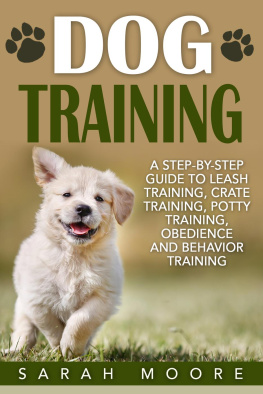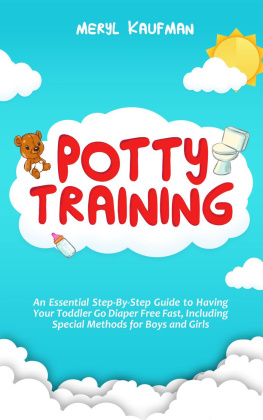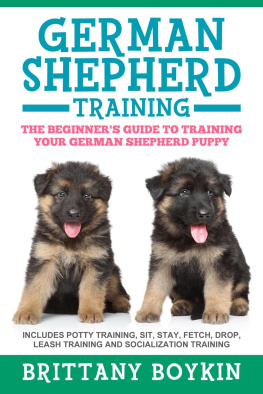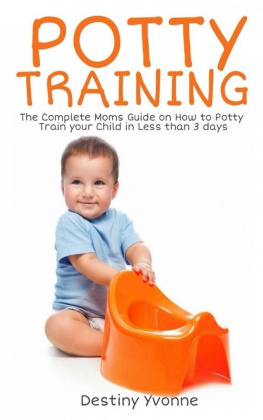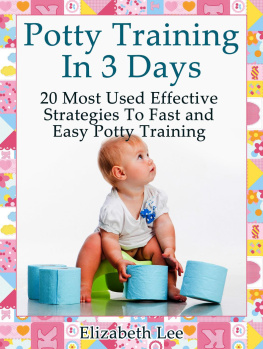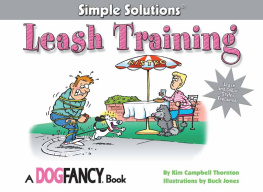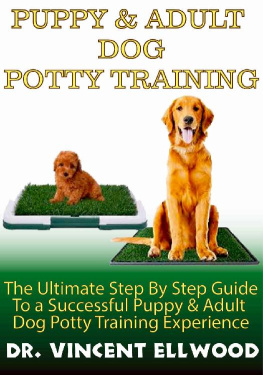Dog Training
A Step-by-Step Guide to Leash Training, Crate Training, Potty Training, Obedience and Behavior Training
Sarah Moore
Text Copyright 2017 Sarah Moore
All rights reserved. No part of this book may be reproduced in any form without permission in writing from the publisher except in the case of brief quotations embodied in critical articles or reviews.
Disclaimer
Every effort has been made to ensure the accuracy of the information contained in this book at the time of publication. The advice contained herein may not be suitable for your situation. The author and publisher do not assume any legal liability or responsibility for any loss or damage that may result from the use of the information in this book.
The contents in this book are for information and educational purposes only. The opinions and suggestions in this book are not intended to replace professional advice. If you have concerns about your dogs health, please consult a veterinarian.
Table of Contents
Introduction
A dog brings joy, excitement and loyal companionship to his family. Once you add this bundle of energetic fur and fuzz to your family, you'll find you have extra reasons to be playful. It's not all cuddles and games of fetch, however. Dogs need to learn how to behave, and your dog will be counting on you to show him how to live in the world.
An obedient and trained dog is a happy dog and a much better family member. Most people train their dogs as a means of disciplining their pets, and many residential communities require that dogs in the neighborhood be well trained.
There are many different theories about how to train a dog. Some people believe in firmness and strict commands that come with consequences. Other schools of thought will tell you that providing rewards for good behavior and withholding rewards for bad behavior is the best way to train a puppy. The best course of action really depends on your dog and the animal's specific personality. The good news is that you do not have to be some type of dog whisperer in order for you to train your dog appropriately.
This book features proven methods and step-by-step instructions for training your dog. Chapter 1 introduces leash training. Chapter 2 shows how to begin crate training. Potty training is one of the most important tasks when a puppy comes home. This is covered in Chapter 3. In addition, Chapter 4 explains how to teach your dog the five basic obedience commands every dog should know, and Chapter 5 provides effective suggestions on how to stop destructive behaviors. Chapter 6 finishes the book with some tips and tricks you can use when you are training your dog.
There is nothing like coming home to the love of a dog after a long and stressful day at work. This book will help you train and bond with your dog, integrate him into your family, and enjoy his loyal companionship.
Chapter 1: Leash Training
L earning how to properly walk on a leash is an important skill to teach your dog. Even if you live on a farm with acres and acres of land for your dog to explore, you'll want to get the dog comfortable on a leash so it's prepared for the days you spend off the farm and out in the world.
Lease training will require patience, consistency and treats that reward good behavior. It shouldn't take too long for your dog to figure out what is happening and walking on a leash will fall into place.
Collar and Leash
T he first step in leash training your dog is to choose the proper collar and leash. There are dozens of different collar and leash styles to choose from, and the best one for you will depend on your dog. You should choose a light, flat collar and a light leash for a puppy, because your puppy is not used to having the extra weight around his neck, making it hard for him to focus on what you are trying to teach him. You can move onto other forms of collars after your puppy has grown up. There is no need to purchase a choke chain or choke collar, because rewarding the positive behavior will be enough to reinforce any behavior you are trying to teach the dog.
Follow the Leader
T he best leash training technique starts with teaching your dog to follow you. When you are leash training your dog, you must reward good behavior with treats, which you can find in pet shops and grocery stores. Choose treats your dog likes and ones that have high protein and low fat.
Bring your dog to a safe, enclosed space. Encourage your dog to sit near where you are standing and when that happens, reward your dog with a treat. Then, take five or six steps forward and wait for the dog to follow you. When that happens, provide another treat. Keep doing this until your dog gets the idea. It won't take long for this pattern to develop into a habit. The dog will want those treats, and it will quickly learn how to give you the expected behaviors in order to win them.
How to Attach a Collar and Leash
T he next step is to allow the dog or puppy to get used to the collar. Put the collar on when there are other things occupying his mind. Attach the collar when you are playing with him. Sometimes a dog will try to remove the collar, even trying to chew it off the neck. If he does this, gain his attention, and encourage him to simply follow you, or get him to play with a toy so he will forget the irritation.
Apply the collar so that it fits the dog while still leaving some room for movement. Make sure it is not so tight as to be uncomfortable or irritating.
The next step in leash training your dog is to introduce the dog to the leash. This can have two effects on the dog. Some dogs react to the leash with crazy behavior that might remind you of a horse that has not been broken. The dog will flip, kick, and roll around as if he had lost his mind. Others will simply shut down, lie still, and refuse to move.
When you first attach the leash, no matter how your dog reacts, simply release your end of the leash. Begin playing with the dog, allowing him to drag the leash around while he plays. This will allow your dog to feel the weight of the leash and get used to it. Make sure there is nothing that will be in the way for the leash to catch on or pull.
How to Teach Your Puppy to Walk on a Leash
N ow it is time for you to begin training your dog on the leash. Make sure you have a calm environment, free from distractions in which to train the dog or puppy.
Once a dog understands what a leash is for, he will often times become very excited when seeing it. He may jump, spin, bark, or even whine. To avoid reinforcing this behavior, you should stand completely still until the dog calms down.
After the dog has calmed down, attach the leash to the collar. Whenever you take the dog for a walk, make sure you have a treat that is small and can be eaten quickly. If the treat is too large or it takes a lot of time for the dog to chew it, training will be interrupted.
Next, you'll hold the leash while walking with your dog. The first few times you do this, you'll want to be careful not to pull on the leash. Many dogs react to the feeling of tightness around their collar when the leash is pulled. It frightens them, and they'll either erupt into a frenzy trying to get free or they'll sit down and refuse to move no matter how hard you tug and pull. When this happens, take a few steps away while holding the leash, but don't pull. Call him to you and when he walks over to you, reward him with a treat. After you have given the dog a treat, continue on with your walk repeating this behavior each time he lies down. If the dog looks as if he might feel nervous, which is completely normal, you can bend down in front of the dog, pet him, and talk in a soothing voice before beginning to walk again.
Next page
